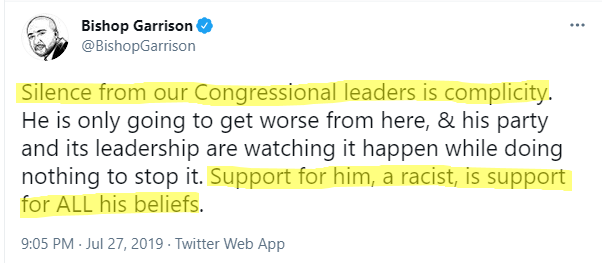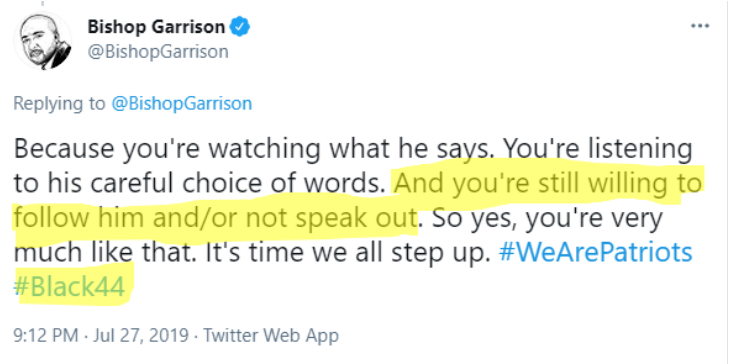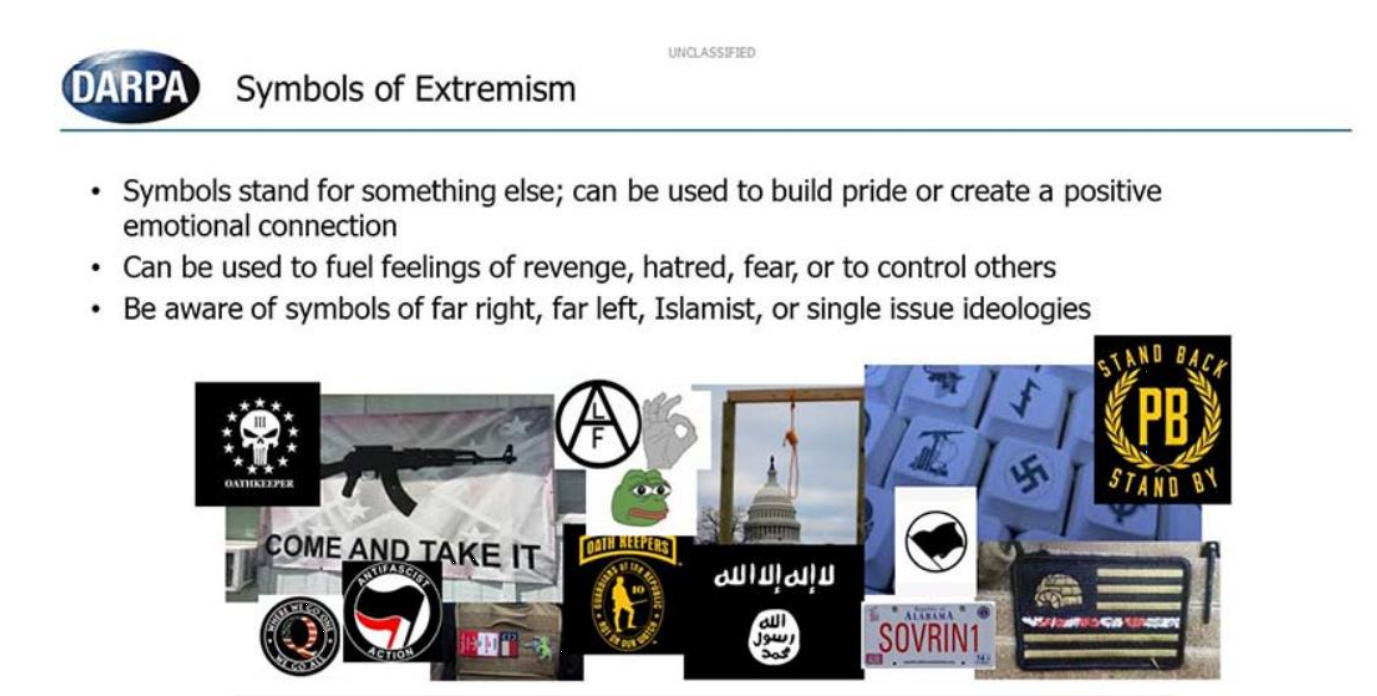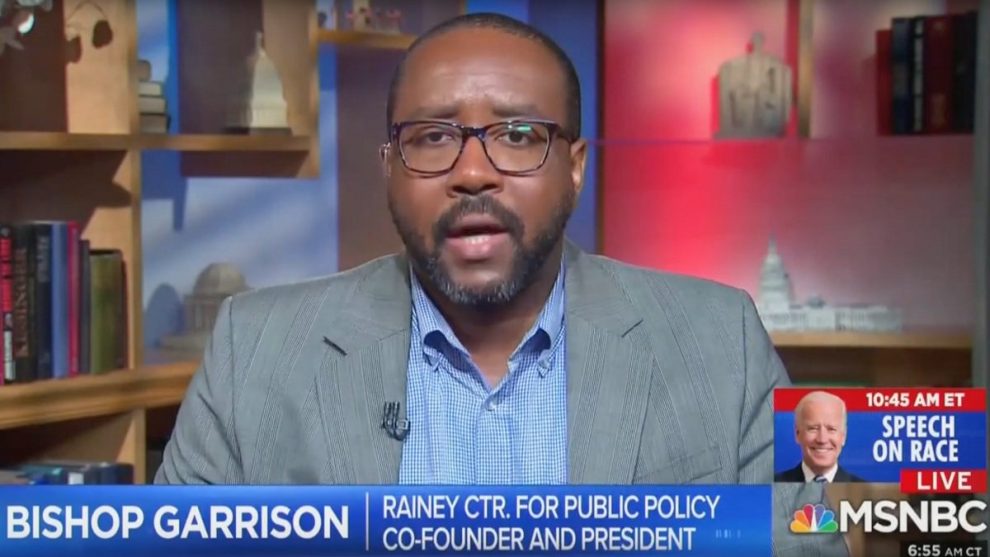On February 3, 2021, in the wake of the “deadly events” of 1/6, Biden’s new Defense Secretary Lloyd Austin ordered a 60-day stand-down and total purge of the U.S. military’s rampant, undefined “extremism” problem. Though the details of this purge were always kept vague and framed in apolitical terms, it was immediately obvious the target would be MAGA — with the buzzword “extremism” tagged onto various proxies for Trump supporters, conservatives, and opponents of globalism of all stripes.
We now know the hatchet man the Pentagon has selected to carry out this MAGA purge of the American defense forces, and the entire operation is worse than you could have ever imagined.
The Biden administration has just put the equivalent of Ibram X. Kendi in charge of vetting the entire U.S. military.
This hatchet man’s name is Bishop Garrison, Senior Advisor to the Secretary of Defense for Diversity and Inclusion:
In a tweet thread from July 27, 2019, Bishop Garrison wrote:



This isn’t just some random case of Trump Derangement Syndrome on Twitter.
As the new head of the U.S. military’s “Countering Extremism” task force, this critical race theory loving, Trump Derangement Syndrome suffering, fake news spreading, 100% partisan hack is the man who will now separate permissible “opinion” from purgeable “extremism” at the Pentagon, which is the nation’s largest employer, overseeing 2.9 million personnel.
Just as the Defense Secretary’s 60 day stand down to take stock of “extremism” within the military’s ranks expired, the Pentagon issued a formal memo on April 9th describing its “Immediate Actions to Counter Extremism.” This memo establishes the Countering Extremism Working Group (“CEWG”) to develop and implement all “Counter Extremism” policies at the Pentagon.
Bishop Garrison is at the helm.
From the memo:
The [CEWG’s] immediate actions are as follows:
Review and Update of DODI 1325.06 Extremism Definition: Office of the Secretary of Defense (Personnel & Readiness) and the Office of the General Counsel (OGC) will review and update DODI 1325.06 to more specifically define what constitutes extremist behavior.
Updating the Service Member Transition Checklist: The military departments will add provisions to their service member transition checklists that include training on potential targeting of service members by extremist groups and work with other federal departments agencies to create a mechanism by which veterans have the opportunity to report any potential contact with an extremist group should they choose to do so.
Review and Standardization of Screening Questionnaires: All military departments to update and standardize screening questionnaires to solicit specific information about current or previous extremist behavior.
Commission of Extremism Study: The Department will commission a study on extremist behavior within our Total Force, to include gaining greater fidelity on the scope of the problem.
Led by Bishop Garrison, Senior Advisor to the Secretary of Defense on Human Capital and Diversity, Equity and Inclusion, the CEWG will oversee the implementation of immediate actions as well as the development of mid-term and long-term recommendations for the continued engagement of this issue. The CEWG will report through the Workforce Management Group (WMG) to the Deputy’s Workforce Council (DWC). [U.S. Department of Defense]
From the above, we learn that Bishop Garrison will lead the CEWG, which will function as a de facto “Opinion Police” for Pentagon personnel on a permanent, go-forward basis.
The CEWG’s first tasks will be: to change the Pentagon’s definition of “extremism”; to stop Pentagon personnel from being recruited by “extremist” groups; and to beef up personnel screening to better detect hidden “extremist beliefs.”
But what exactly are “extremist beliefs” and “extremist materials”?
A leaked 17-page DARPA memo from March 27, 2021 entitled “Extremism and Insider Threat in the DoD” provides a clue as to what new categories of lawful thoughts, associations and reading materials are likely to be scanned and banned by Bishop Garrison’s CEWG. DARPA, the Defense Advanced Research Projects Agency colloquially known as “The Pentagon’s Brain,” recommended a brand new category called “Patriot Extremism,” which occurs when a citizen believes “the US government has become corrupt” or “has overstepped its constitutional boundaries”:

“Patriot Extremism” is completely distinct from “White supremacy,” which DARPA maintains as a wholly separate category. To DARPA’s credit, they did at least add a new category for “Anarchist Extremism,” which purports to target some degree of left-wing political organization. But DARPA’s “Symbols of Extremism” collage on page 6 clearly reveals their intended target: the collage includes 12 “far-right” symbols, versus just two Antifa symbols, and just one for ISIS. “Extremist” “far-right” symbols include Pepe the Frog, the OK hand gesture, “Come and Take It” guns-rights memes, and the “Q” in QAnon:

So now it’s up to Bishop Garrison’s CEWG to take DARPA’s “extremism” proposals and either implement them, throw them in the trash, or come up with something new.
We already have a good idea of Bishop Garrison’s views from the egregious anti-Trump tweets presented above.
But since Bishop Garrison will effectively be the vetter-in-chief responsible for culling the entire U.S. military of any potential “extremist” in its ranks, it’s only fair that Bishop Garrison’s own “extremist” Internet footprint be more thoroughly exposed — and with it the entire sham of his dangerous project to politicize and purge America’s defense forces.
The Critical Race Theory Zealot
Bishop Garrison is an ardent advocate of the so-called “1619 Project.” In August 2019, he instructed his followers to stop whatever they were doing and read 1619‘s 100-page spread in the Sunday Times immediately.
Recall that the “1619” in the 1619 Project refers to the year in which the first slaves arrived at the British Colonies. Spearheaded by the New York Times’s Nikole Hannah Jones, the idea of the 1619 Project is to replace 1776 with 1619 as the year of America’s founding, with a view toward casting the U.S. as fundamentally evil and unjust. The New York Post explains “How the 1619 Project Slandered America”:
In the absence of traditional public examinations this time of year, as a result of you know what, here’s a little history quiz for you. What year marked the creation of the United States?
Most of you will probably answer 1776, the year of the Declaration of Independence. Credit might also be given if you said 1788, the date of the ratification of the Constitution.
You’d all be wrong. The correct date, apparently, is 1619.
This was the year the first slaves arrived in the British colonies of North America, and if the people who control most of the cultural conversation in America these days get their way, we should all see this as the true moment of the founding of the nation. The point, of course, is that it defines America as a nation built not on the lofty ideals of freedom and self-government laid out in the document written by the Founding Fathers, but as one built on the degradation, dehumanization and persecution of black people. [NY Post]
The 1619 Project is not simply critical of certain aspects of American history. Rather, it recasts and redefines America as fundamentally evil, and is therefore anti-American in this most direct and literal sense. The 1619 agenda is so controversial that Republicans in 5 states sought to ban schools from incorporating its anti-American poison in their curricula. Even Mitch McConnell, hardly the brave culture warrior, piped up to address the 1619 Project’s anti-American slander.
So vicious and subversive is the 1619 Project’s slander of America that one of Donald Trump’s last actions as President was to set up a 1776 Commission dedicated to correcting its damaging lies about what America fundamentally is. Of course, Biden made sure to do away with this just days after taking office.
As a final confirmation of the anti-white, anti-American agenda behind the 1619 Project, its founder Nikole Hannah-Jones was revealed to have referred to the “white race” as “bloodsuckers” and “barbaric devils,” and Christopher Columbus as “no different than Hitler.”
Such is the nature of the 1619 Project that Bishop Garrison, ideological vetter-in-chief for the United States military, promoted so enthusiastically as “stories we all need to hear.”
The most generous and willfully blind might write off Bishop Garrison’s promotion of the 1619 Project as an extraneous interest that wouldn’t have an effect on his current definition of “extremism” or on his present role in vetting extremism from the U.S. Armed Forces. Think again.
In an August 2019 screed entitled “Racism is an existential threat“, Bishop Garrison directly connects his support for the 1619 Project to his conception of “white nationalist extremism” as the pre-eminent security threat facing the United States:
The country’s horrific history on race and its continued refusal to engage these problems head-on has exacerbated the issue to the point of a violent crisis. This crisis continues to seep into our state and local domestic policies, our technologies, the algorithms of social media companies, and (potentially) our future like a corrosive poison contaminating a water table. We will continue to face the nation-ending threat of white supremacy and white nationalist extremism unless we invest in Combating Violent Extremism (CVE) programs, which this administration has cut, and find the courage to have honest-to-God difficult, uncomfortable conversations in our homes and communities about our history of race and privilege in America and how it has shaped our lives today.
An example of this in practice is the New York Times Magazine’s 1619 Project, a series of opinion pieces, poetry, essays, and historical works designed to inform readers on the treatment and history of slavery, segregation, and Jim Crow laws in America. The project’s title comes from the August anniversary of the arrival of the first African slaves, 20-30 individuals from what is now modern-day Angola, in the British American colonies. Each work highlights not only past atrocities and injustices experienced by black Americans, but ongoing systemic issues that have plagued the nation from its original sin of slavery into the present day. It’s an important effort that may very well shape the dialogue around race, inclusion, and the need for steadfast policies that may one day fill the discriminatory gaps in our society and help heal the country. And the effort is, somehow, in 2019, controversial.
While pundits clutch pearls and attempt to convince us that the 1619 Project is a lie, that it’s really white society under attack, and that we’re in a post-racial society because we once had a black man as president, more radicalized white supremacists will shoot up schools, markets, stores, and places of worship to assert their ideology. We are not required to blindly believe pundits. We must not be bullied by maniacs who seek power through semi-automatic rifles. We must not run from engagement with each other; the change we desire can be achieved through heartfelt, frequently difficult, and awkward conversations among family, friends, and neighbors about race and its continued impact on our lives. Reading the 1619 Project is a good place to start. [InkStickMedia]
When Secretary of State Mike Pompeo made a speech denouncing 1619 for the ahistorical anti-American poison that it is, Bishop Garrison labeled Pompeo’s criticisms not merely a different opinion, but “dangerous.”
Let’s take a moment to take stock of what we’ve learned. The leader of the Pentagon’s Orwellian ideological vetting operation not only enthusiastically promotes the viciously anti-American 1619 Project, he characterizes anyone who would dare criticize it as “dangerous.”
The brave patriots who serve in the U.S. military are required to take an oath to the Constitution. But if Bishop Garrison has his way (and given his current position, it looks like he will) only those who believe America is a fundamentally evil and racist nation will be permitted to take the oath to defend America — a bizarre dystopian twist if there ever was one!
Contextualizing contrary opinions as “dangerous” is especially troubling in light of Bishop Garrison’s grift in the national security sector. By designating lawful groups, people, associations or ideas as “dangerous,” a national security predicate is created to eliminate them. Since the national security apparatus controls the commanding heights of America’s intelligence agencies (which are functionally above the law under NSC 10-2), military branches, State Department diplomats, Treasury Department powers and Federal law enforcement organs, national security predicates are the ultimate “trump card” to bypass democratic processes.
Put another way, if every issue were a national security issue, we would have martial law, not a Constitutional republic.
This undemocratic override is why national security apparatchiks are supposed to stay in their lane, focus on defense, and stay out of civilian policy. Labeling a target a “threat to national security” not only moots civilian debate, it moots all FOIAs and public inquiries into what military-intelligence is even up to behind closed doors.
But Bishop Garrison, the ultimate vassal for an agenda he is likely wholly unaware of, seeks long-arm jurisdiction for the U.S. security state on all things “diversity, equity and inclusion.” Which leads us to Bishop Garrison’s main grift in the critical race theory racket: “White Supremacy is a national security threat.“
On December 10, 2019, Bishop Garrison testified at a House Armed Services Committee hearing titled “Diversity in Recruiting and Retention: Increasing Diversity in the Military – What the Military Services are Doing”.
The transcript reads, in relevant part:
[P]romoting inclusivity and respect within the ranks is not only the right thing to do morally but also a matter of national security: a more cohesive unit is a stronger fighting force. Moreover, in order to address a diverse set of threats across the globe, we must strive to include a diverse set of life experiences and perspectives…
It’s also important to note that some of the current discourse in American society and some of the current administration’s policies could be affecting interest in serving, especially among minorities. The militarization of our nation’s southern border; the deportation of veterans; the potential rescission of the Parole in Place program; tenuous status of Dreamer service members and veterans; the transgender service ban; the fact that many major military bases are still named after Confederate leaders; the ongoing worries about white nationalism in the military’s ranks; and the fact that an individual who holds extreme views on race, continues to serve at the highest level of immigration policy-making—these factors risk causing a detrimental impact on our military’s ability to recruit and retain new and diverse talent. [YouTube]
By “an individual who holds extreme views on race who continues to serve at the highest level of immigration policy-making,” Bishop Garrison meant then White House Senior Policy Advisor, Stephen Miller.
To Bishop Garrison, people like Stephen Miller are not legitimate officials with mere opinion or policy differences that should be resolved at the civilian level: they are national security threats that should be dealt with at the military level. So says the new head of the Pentagon Opinion Police.
But Bishop Garrison’s sleight of hand reasoning here is so clever, so understated, and yet so breathtakingly sweeping that it’s unlikely he had anything to do with inventing it.
Here’s how the scam works:
Once you accept that the Pentagon’s diversity, equity and inclusion policies are a matter of national security, then anything that undermines diversity, equity and inclusion is now deemed a national security threat. That’s all it takes for the empty vessel of Bishop Garrison to sweep all policies and personnel that supported Donald Trump’s border wall, illegal alien deportations, DACA criticism, transgender military ban, and military bases named after Confederate leaders into “threats to national security” jurisdiction.
In short, critical race theory is no longer just the poison academics use to train American schoolchildren to hate their country — it is the animating agenda of the United States Military, the most powerful fighting force in world history.
Bishop Garrison’s public remarks on George Floyd offer a shocking and terrifying glimpse into what this means in practice.
At the height of the George Floyd riots in June 2020, Garrison penned “An Appeal to the National Security Community to Fight Racial Injustice,” in which he argues “there is no security abroad without justice at home.” In the op-ed, Garrison crusaded against the very concept of objectivity in the U.S. national security state and called for the national security apparatus to “cut out” the “cancer” of racism.
It is a convention in national security analysis to strike as objective a tone as possible. Experts who focus on how inequality and injustice undermine security are often taken less seriously than those who focus on weapons development or military strategy. This, too, reflects the structural tunnel vision in our community that has to change. In this spirit, if we are not all actively aware of how racial injustice undermines our security and if we do not integrate efforts to combat it into our work and policy initiatives, then we will be part of the problem and guilty of undercutting our own security.
The United States faces a historic moment that provides an opportunity for the national security community to both discuss and act on the issues of race and extremism—and how they affect our security, diplomatic relationships, and credibility abroad. The racism that threatens lives and security will not magically vanish. It will not draw back or resolve itself. It must be cut out like the cancer it has been for so long. The national security community can strengthen the nation of which it is a part by being not just an ally of those who want change, but also an active participant in this dialogue and effort. The battles for the security and moral authority of the United States are intrinsically linked. [Foreign Policy]
It will not come as a surprise to the reader that the epidemic of arson and death caused by Black Lives Matter fails to register as a matter of moral or national security concern for Bishop Garrison. Rioting in 140 cities, $2 billion in property damage, shooting policemen in the head, and single-handedly kicking off a 30% nationwide increase in homicide, and what does Bishop Garrison have to say about it? Nothing?
77-year-old St. Louis retired Police Captain David Dorn was shot dead by rioters when he tried to get them to stop looting. #BlackLivesMattter
Say his name #blackoutuesday pic.twitter.com/oKMwZFPa1d
— Cassandra (@CassyWearsHeels) June 2, 2020
Actually, worse than nothing. Instead of similarly pursuing BLM as a national security threat, Bishop Garrison attacked “the deafening silence of veteran service organizations” who failed to support BLM.
According to Biship Garrison, anything that falls outside of the ideological boundaries of an MSNBC host is not only wrong, but a national security threat.
Consider Bishop Garrison’s tweet below calling Bill Maher a racist. Bill Maher can now be banned for life from all U.S. military organs. Not for being insensitive (which is First Amendment-protected speech), but because Bill Maher is now a national security threat because he made a joke (below) undermining racial minority recruitment, retention, leadership, and morale.
By the same logic, Revolver News could now be deemed a national security threat by publishing this article, justifying counterintelligence countermeasures such as surveillance and infiltration. Ironically, these are exactly the types of abuses that initially prompted the 1975-76 Church Committee hearings, after Christopher Pyle’s 1970 whistleblower series revealed Army Counterintelligence and the FBI had been spying on every major civilian political movement in the country, including ordinary women’s groups.
Story cited here.
























